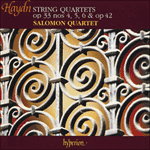
Welcome to Hyperion Records, a British classical label devoted to presenting high-quality recordings of music of all styles and from all periods from the twelfth century to the twenty-first.
Hyperion offers both CDs, and downloads in a number of formats. The site is also available in several languages.
Please use the dropdown buttons to set your preferred options, or use the checkbox to accept the defaults.

| Salomon Quartet» More |
Subversive comedy continues in the Scherzo, with its crazy offbeat accents and imitative entries: in a game of musical chairs, the viola ends up stranded with the opening motif. The trio restores rhythmic decorum, beginning as a lolloping cello solo before morphing into a canonic duet for first violin and viola. As in Op 33 No 5, the slow movement is usually placed second, but in Schmitt’s Amsterdam edition comes third. Again it is in the tonic minor key, with something of a Baroque flavour. But the texture is more varied and complex than in No 5. Above the opening theme, gravely intoned by second violin and viola, the first violin’s sustained high A recreates the vocal technique of messa di voce (literally ‘placing the voice’), involving a perfectly controlled gradual swelling and ebbing of the tone, and indispensable to any eighteenth-century singer’s armoury.
As in No 5, Haydn offsets a fast first movement with a relaxed variation finale. This is the earliest example in his quartets of his favourite ‘double variation’ form, with alternating sections of major and minor. The D minor theme, initiated by the cello, is a classic instance of the free, informal counterpoint that is one of the glories of Op 33.
from notes by Richard Wigmore © 2013
La comédie subversive se poursuit dans le Scherzo, avec ses accents insensés sur les temps faibles et ses entrées imitatives: dans un jeu de chaises musicales, l’alto se retrouve bloqué avec le motif initial. Le trio restaure la normalité rythmique, en commençant sur un solo de violoncelle qui évolue à grandes enjambées maladroites avant de se transformer en un duo en canon entre le premier violon et l’alto. Comme dans l’op. 33 nº 5, le mouvement lent est normalement placé en deuxième position, mais selon l’édition d’Amsterdam de Schmitt il vient à la troisième place. Une fois encore, il est à la tonique mineure, avec un certain parfum baroque. Mais la texture est plus variée et complexe que dans le nº 5. Au-dessus du thème initial, gravement déclamé par le second violon et l’alto, le la aigu soutenu du premier violon recrée la technique vocale de la messa di voce (littéralement «en plaçant la voix»), impliquant d’enfler et de réduire le son de manière parfaitement contrôlée, procédé indispensable à tout arsenal de chanteur du XVIIIe siècle.
Comme dans le nº 5, Haydn compense un premier mouvement rapide par un finale détendu en forme de variations. C’est la première fois que l’on rencontre dans ses quatuors sa forme préférée de «double variation» avec l’alternance de sections en majeur et en mineur. Le thème en ré mineur, amorcé par le violoncelle, est un cas classique du contrepoint informel libre qui est l’une des splendeurs de l’op. 33.
extrait des notes rédigées par Richard Wigmore © 2013
Français: Marie-Stella Pâris
Die komisch-subversiven Elemente setzen sich im Scherzo fort, wo verrückte Offbeat-Akzente und imitative Einsätze vorkommen: bei einer Runde der „Reise nach Jerusalem“ bleibt die Bratsche mit dem Anfangsmotiv übrig. Im Trio wird der rhythmische Anstand wiederhergestellt; es beginnt mit einem umherhüpfenden Cello-Solo, bevor es sich in ein kanonisches Duo für die erste Geige und Bratsche verwandelt. Ebenso wie bei op. 33 Nr. 5 wird der langsame Satz, der normalerweise an zweiter Stelle kommt, gemäß der Amsterdamer Schmitt-Ausgabe an dritter Stelle platziert. Wiederum hat er eine Molltonika und mutet zudem barock an. Jedoch ist die Struktur in diesem Satz abwechslungsreicher und komplexer als es in Nr. 5 der Fall ist. Über dem Anfangsthema, das in ernsthafter Weise von der zweiten Violine und Viola intoniert wird, bildet das ausgehaltene hohe A der ersten Violine die Gesangstechnik messa di voce (wörtlich: „Platzierung der Stimme“) nach, wobei ein sorgfältig kontrolliertes An- und Abschwellen eines lang ausgehaltenen Tons stattfindet—ein unentbehrlicher Bestandteil im Waffenarsenal eines jeden Sängers des 18. Jahrhunderts.
Ebenso wie in Nr. 5 stellt Haydn dem schnellen ersten Satz einen entspannten Variationensatz als Finale gegenüber. Hier kommt zum ersten Mal in seinen Quartetten die „Doppelvariationsform“ vor, für die er eine besondere Vorliebe hegte und bei der abwechselnd Abschnitte in Dur und Moll vorkommen. Das d-Moll-Thema, das vom Cello begonnen wird, ist ein klassisches Beispiel für den freien, informellen Kontrapunkt, der zu den besonders schönen Charakteristika von op. 33 gehört.
aus dem Begleittext von Richard Wigmore © 2013
Deutsch: Viola Scheffel
 Haydn: String Quartets Opp 33/4-6 & 42 Haydn: String Quartets Opp 33/4-6 & 42‘Virile, colourful performances … sharply responsive to the music's robust earthiness and gleeful unpredictability’ (Gramophone) 'Assolutamente magnifica' (Musica, Italy)» More |

